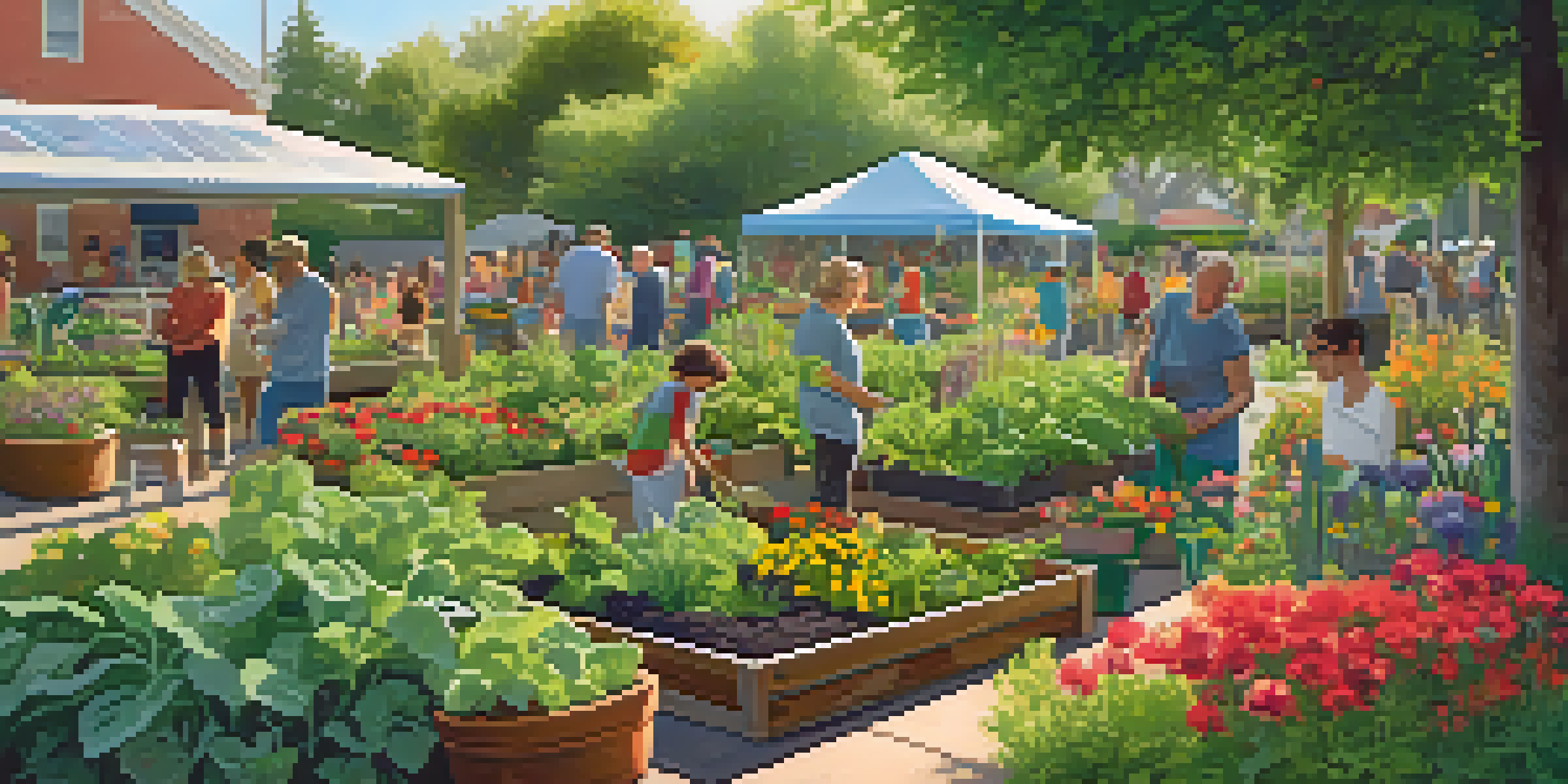Community Gardens: Promoting Health and Sustainability

What Are Community Gardens and Their Purpose?
Community gardens are shared plots of land where individuals come together to grow plants, vegetables, and flowers. These spaces not only beautify neighborhoods but also serve as a focal point for community engagement. The purpose of these gardens extends beyond mere gardening; they foster a sense of belonging and cooperation among participants.
Gardening adds years to your life and life to your years.
These gardens often reflect the diverse cultures and backgrounds of their members, making them vibrant hubs of activity. For example, a community garden can feature crops from various cuisines, allowing participants to share recipes and culinary traditions. This exchange enriches the community and encourages inclusivity.
Moreover, community gardens provide educational opportunities for all ages. Workshops on sustainable gardening practices, composting, and healthy eating can empower members to adopt greener lifestyles and make informed food choices.
Health Benefits of Community Gardens
Engaging in gardening activities has numerous health benefits, both physical and mental. Studies show that spending time in green spaces reduces stress and anxiety, while also encouraging physical exercise. Whether you’re digging in the dirt or harvesting vegetables, community gardening promotes an active lifestyle.

Additionally, growing your own fruits and vegetables leads to healthier eating habits. When people have easy access to fresh produce, they’re more likely to include it in their diets. This direct connection to food can inspire healthier choices and even spark interest in cooking.
Health Benefits of Gardening
Engaging in community gardening promotes physical activity and encourages healthier eating habits.
The social interactions within community gardens further enhance mental well-being. Participants often form friendships and support networks, which are crucial for mental health. Sharing experiences, tips, and even challenges in the garden fosters a sense of community that can combat feelings of isolation.
Environmental Sustainability Through Gardening
Community gardens play a vital role in promoting environmental sustainability. By transforming vacant lots into green spaces, these gardens help improve local air quality and reduce urban heat. Plants absorb carbon dioxide and release oxygen, contributing to a healthier environment for everyone.
The best time to plant a tree was 20 years ago. The second best time is now.
Moreover, community gardens encourage biodiversity by providing habitats for various species. Pollinators like bees and butterflies thrive in these spaces, which are essential for the ecosystem. This focus on biodiversity helps combat the decline of these crucial species.
Practicing sustainable gardening techniques, such as composting and crop rotation, can also minimize waste and promote soil health. Participants learn to utilize natural resources effectively, which can inspire them to apply these principles in their own homes and communities.
Building Community Connections
One of the most significant outcomes of community gardens is the strengthening of neighborhood ties. These gardens serve as gathering places where people can come together, share ideas, and collaborate on projects. This sense of unity fosters increased social capital and trust among residents.
Events such as potlucks, harvest festivals, and volunteer days further enhance community bonds. By working side by side, participants not only cultivate plants but also friendships and a sense of belonging. These connections can lead to broader initiatives that benefit the entire community.
Community Gardens Foster Connection
These shared spaces enhance community bonds by bringing people together to cultivate plants and friendships.
Additionally, community gardens can empower residents to advocate for local issues. When people feel a stake in their environment, they are more likely to engage in discussions about urban planning, food justice, and sustainability initiatives.
Education and Skill Development
Community gardens serve as excellent educational platforms, teaching valuable skills to individuals of all ages. From planting seeds to harvesting crops, participants learn about the lifecycle of plants and the importance of nutrition. This hands-on experience can ignite a lifelong passion for gardening and environmental stewardship.
Workshops and classes often accompany community garden initiatives, covering topics like organic gardening, pest management, and seasonal planting. These opportunities for skill development can empower individuals, equipping them with knowledge they can apply at home.
Furthermore, kids and teens involved in community gardens can develop teamwork and leadership skills. By engaging in collaborative projects, they learn to communicate effectively and take responsibility for their contributions, which are vital skills for future success.
Economic Benefits of Community Gardens
In addition to their social and environmental impacts, community gardens can also bring economic benefits to neighborhoods. By providing fresh produce, these gardens contribute to food security, especially in areas known as food deserts, where access to fresh food is limited. This helps families save money while improving their diets.
Community gardens can also create job opportunities through market gardens, where surplus produce is sold at local farmers' markets. This not only generates income for participants but also supports the local economy by keeping money within the community.
Sustainability and Education
Community gardens promote environmental sustainability while providing valuable educational opportunities for all ages.
Moreover, the presence of community gardens can increase property values and attract new residents interested in sustainable living. This influx can lead to further investment in the community, creating a cycle of growth and opportunity.
Challenges and Solutions in Community Gardening
While community gardens offer numerous benefits, they also face challenges that can affect their sustainability. Issues such as funding, land access, and maintenance often arise, making it difficult for gardens to thrive long-term. However, these challenges can be addressed through community collaboration and creative problem-solving.
For instance, forming partnerships with local businesses or organizations can provide essential resources and support. Grants and fundraising events can help secure funding for necessary materials and infrastructure. By pooling resources, community members can ensure their gardens remain vibrant and productive.

Additionally, establishing clear guidelines and responsibilities within the gardening community can help maintain the space and keep it welcoming for all. Regular meetings and open communication allow members to voice concerns and brainstorm solutions collectively, ensuring the garden remains a cherished community asset.